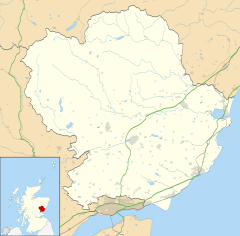Kirriemuir, Angus
Kirriemuir
|
|
|---|---|
 Kirriemuir, Peter Pan Statue |
|
| Kirriemuir shown within Angus | |
| Population | 5,910 (est. 2006) |
| OS grid reference | NO385535 |
| Council area | |
| Lieutenancy area | |
| Country | Scotland |
| Sovereign state | United Kingdom |
| Post town | KIRRIEMUIR |
| Postcode district | DD8 |
| Dialling code | 01575 |
| Police | Scottish |
| Fire | Scottish |
| Ambulance | Scottish |
| EU Parliament | Scotland |
| UK Parliament | |
| Scottish Parliament | |
Kirriemuir, sometimes called Kirrie, is a burgh in Angus, Scotland. Its history reaches back to earliest recorded times, when it seems to have been a major ecclesiastical centre. Later it was identified with witchcraft, and some older houses still feature a ‘witches stane’ to ward off evil. In the 19th century, it was an important centre of the jute trade. The playwright J.M. Barrie was born and buried here, and a statue of Peter Pan stands in the town square.
The history of Kirriemuir extends to the early historical period and it appears to have been a centre of some ecclesiastical importance. The Kirriemuir Sculptured Stones, a series of late Pictish cross slabs, are now on display at the Meffan Institute in Forfar.
Kirriemuir has a history of accused witches back in the 16th century. Many of the older buildings have a witches stane built in to ward off evil. This is a hard grey stone set into the local red sandstone which the buildings were built from. A pond on the outskirts of town, known as the Witch Pool, was where the supposed witches were meant to have been drowned but the alleged pool was in fact the mill pond of the 19th Century Meikle Mill. Local amateur historians tend to think this referred to a ‘mickle’ (small—it in fact means large) mill, but the reference is to one of John Meikle's patented chaff-separating machines, based on ideas he picked up in the Netherlands. The adjacent "Court Hillock" was shown, on excavation to make way for a housing development, to be nothing more than the spoil heap left from the excavation and cleaning of the pond.
Though its importance as a market town has diminished, its former jute factories (now manufacturing synthetics) echo its past importance in the 19th century as the centre of a home weaving industry.
Historic features near Kirriemuir include a carved Pictish stone known as the Eassie Stone, found in the bed of a burn near the village of Eassie.
...
Wikipedia

